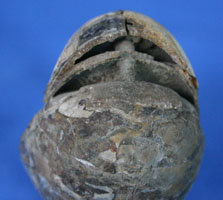Eutrephoceras "elegans" var. nebrascensis is described as having a subglobose (not quite rounded) shell which is broadly round on the flanks (sides) and venter (outside edge). The umbilicus is closed in young to medium sized specimens and involute (only slightly open) in larger specimens. The size of the whorl (a 360 deg. rotation of the shell) increases rapidly with each rotation. with the height and width ratio at 3.5 to 3.0 The sutures (or septum walls) have a straight curve forward near the umbilicus, and slightly backward on the side, then slightly forward again at the venter or outside edge. The shell surface is smooth with distinct growth lines and faint longitudinal costae (ribs). The siphuncle placement is about 1/3rd the distance in from the outside edge. Eutrephoceras nebrascensis has been found along with Didymoceras cheyennense through Baculites eliasi Range Zones (74 - 71 million years ago) and was most prolific during the Baculite compressus and Baculite cuneatus Range Zones (73.5 - 73 million years ago) of the Western Interior of North America.
Many of the ammonites from South Dakota will fluoresce due to the replacement of the shell by calcite and chalcedony. The first photo of this specimen was taken under short wave fluorescent light. The yellow fluorescent mineral is calcite. Any green fluorescence would be chalcedony and any purple is due to the UV lights reflecting off the light colored non-fluorescing minerals in the specimen. Also check out other South Dakota fluorescent offerings under the Fluorescents section. Then click on the "To view specimen material from South Dakota" link. Some other normal light photos will be shown there as well.
The second photo (below) was taken under normal light (no long wave photo is available). This specimen is also available in the fossil ammonite section. It will have the same item number without the trailing "F."
You can see the siphuncle tube connecting the chambers in the photo below.
Eutrepha = nourishing + ceras = horn.
Kingdom: Animalia, Phylum: Mollusca, Class: Cephalopoda, Order: Nautiloidea, Family: Nautilidae, Genus: Eutrephoceras, Species: nebrascensis.
Eutrephoceras nebrascensis 
Quantity in Basket: None
Code: FA-290F
Price: $45.00
Time: Upper Campanian Stage, approximately 73-71 million years ago.
Location: Pierre Shale, South Dakota, USA
Dimensions: 3" x 2-1/2" x 2-1/4"